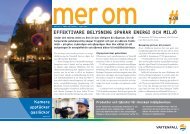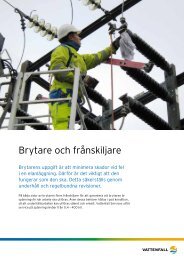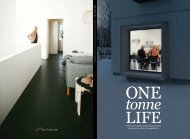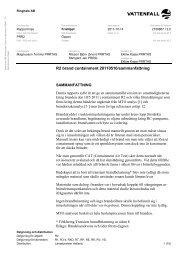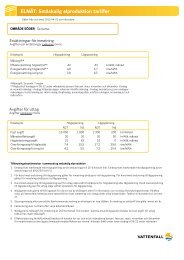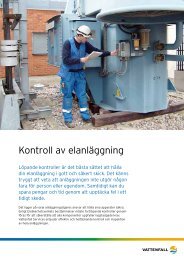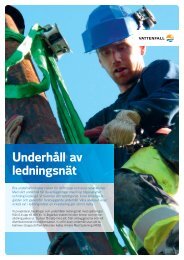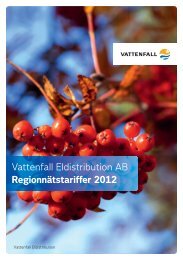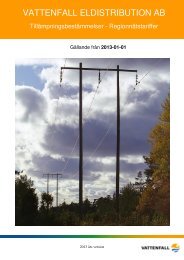This environmental impact assessment for Kriegers flak ... - Vattenfall
This environmental impact assessment for Kriegers flak ... - Vattenfall
This environmental impact assessment for Kriegers flak ... - Vattenfall
You also want an ePaper? Increase the reach of your titles
YUMPU automatically turns print PDFs into web optimized ePapers that Google loves.
12 SUMMARY<br />
any protected values or species. The effects of the<br />
nearby surroundings will there<strong>for</strong>e be limited.<br />
An account of expected <strong>environmental</strong> effects during<br />
the building, operational and dismantling phases is<br />
made below.<br />
The building phase<br />
Noise and vibrations from working vessels and from<br />
foundation work may scare Þ sh and mammals. As the<br />
building phase is limited in time, the <strong>impact</strong> is expected<br />
to be small.<br />
Occurrence of mud and changed sedimentation<br />
may lead to fauna, animals living on the seabed, Þ sh<br />
roe and fry being covered. <strong>This</strong> may lead to reduced<br />
growth or, in the worst case, death. Clouded water<br />
may lead to habitat changes <strong>for</strong> mobile species. The<br />
volume of sediment that will be stirred up during the<br />
construction work depends on the seabed conditions.<br />
The <strong>impact</strong> is limited in time. There are no protectionworthy<br />
species or biotopes to any great extent. Impact<br />
due to clouding and sedimentation is there<strong>for</strong>e judged<br />
to be small.<br />
Operational phase<br />
The wind farm will have an <strong>impact</strong> on the landscape<br />
picture but as the wind farm hardly will be visible from<br />
the shore during daylight, the disturbance onshore<br />
is judged to be small. Whether hazard lights on the<br />
turbines will be visible from the shore during the night<br />
is still not clear as the regulations regarding hazard<br />
lights currently are under review. From closer view, the<br />
turbines will dominate the landscape picture.<br />
The risk of birds colliding with the turbines is<br />
regarded as small since studies have shown that birds<br />
make way <strong>for</strong> offshore-based wind turbines. <strong>This</strong> has<br />
also been conÞ rmed through the studies on collision<br />
risks <strong>for</strong> birds that Sweden Offshore has commissioned.<br />
The risk of ships colliding with wind turbines is<br />
also regarded as very small (0,0006/year or about 1<br />
700 years between two collisions without increased<br />
safety measures and 0,00015/year or about 6 700 years<br />
between two collisions with increased safety measures<br />
being adopted). If an accident occurs, the negative<br />
consequences could be severe.<br />
From the point of the knowledge base of today, the<br />
reaction of Þ sh from underwater noise is judged, in the<br />
worst case, to be local. Noise could lead to Þ sh avoiding<br />
the immediate neighbourhood. It will however in<br />
such case be possible <strong>for</strong> Þ sh getting used to the noise.<br />
If a security zone is established within the designated<br />
area, this could lead to very positive effects <strong>for</strong> the<br />
Þ sh population. A restriction would result in short term<br />
negative effects <strong>for</strong> the Þ shing industry, but would<br />
have positive effects in the longer term (amongst others<br />
through a so called spill-over effect).<br />
Finally, the <strong>impact</strong> on the salt water level is judged<br />
to be negligible.<br />
The dismantling phase<br />
The <strong>impact</strong> during this phase will be similar to that<br />
occurring during the building phase. There will be less<br />
noise, less vibrations and sedimentation as the part of<br />
the foundation that is below the seabed level will be<br />
left in the ground.<br />
Grid connection<br />
The grid connection will be carried out in two phases.<br />
During phase I, a 340 MW cable will be connected<br />
to the grid point Trelleborg Nord and during phase II,<br />
a 300 MW cable will be connected to the grid point<br />
Arrie. The grid connection will be made with 4 threephase<br />
sea cables and 4 three-phase land cables, all AC.<br />
The cables will be trenched some 0.8 meters into the<br />
seabed. Onshore, land cables will be used. Two trans<strong>for</strong>mer<br />
stations will be built within the designated area<br />
<strong>for</strong> the wind farm.<br />
As several countries will build grid connections to<br />
the <strong>Kriegers</strong> Flak area, there are good opportunities<br />
to make better use of the total investment by allowing<br />
transmission between the countries. A proposal is that<br />
this aspect should be considered in future deliberations<br />
and that the potential be analysed closely.





